小学六年级英语语法大全
人教版新版PEP小学六年级上册英语语法表
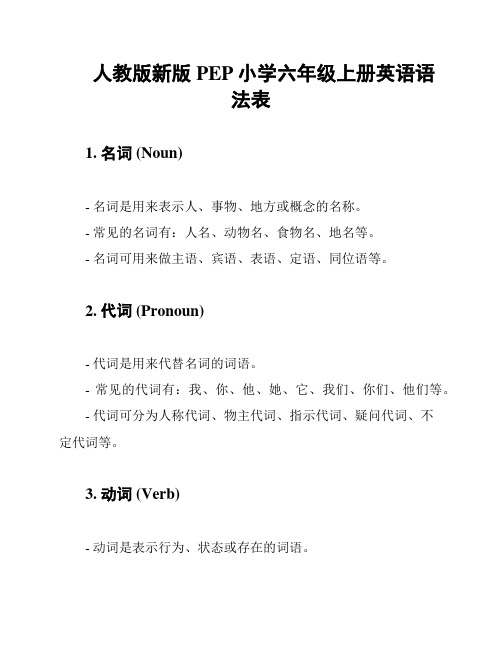
人教版新版PEP小学六年级上册英语语法表1. 名词 (Noun)- 名词是用来表示人、事物、地方或概念的名称。
- 常见的名词有:人名、动物名、食物名、地名等。
- 名词可用来做主语、宾语、表语、定语、同位语等。
2. 代词 (Pronoun)- 代词是用来代替名词的词语。
- 常见的代词有:我、你、他、她、它、我们、你们、他们等。
- 代词可分为人称代词、物主代词、指示代词、疑问代词、不定代词等。
3. 动词 (Verb)- 动词是表示行为、状态或存在的词语。
- 动词分为实义动词和虚义动词,实义动词可以独立构成句子的谓语。
- 动词还可以根据时态、语态、语气等形式进行变化。
4. 形容词 (Adjective)- 形容词是用来描述名词的特点和性质的词语。
- 形容词通常位于名词前面作定语。
- 形容词可以比较级和最高级,并可根据名词的性质进行变化。
5. 副词 (Adverb)- 副词是用来修饰动词、形容词和其他副词的词语。
- 副词可以回答疑问词how、when、where等问题的词语。
- 副词可用来修饰句子和句子的成分。
6. 冠词 (Article)- 冠词是表示名词特指与泛指的词语。
- 冠词分为定冠词和不定冠词,定冠词包括"the",不定冠词包括"a"和"an"。
- 冠词用来限定名词的范围和数量。
7. 介词 (Preposition)- 介词是用来表示名词与其他词之间关系的词语。
- 常见的介词有:in、on、at、above、below等。
- 介词通常位于名词或代词的前面。
8. 连词 (Conjunction)- 连词是用来连接句子、词语或词组的词语。
- 常见的连词有:and、but、or、so等。
- 连词可以连接并列关系、选择关系、原因和结果关系等。
9. 数词 (Numeral)- 数词是用来表示数量的词语。
- 数词分为基数词和序数词,基数词用来表示数量的多少,序数词用来表示次序和顺序。
小学六年级英语语法知识汇总
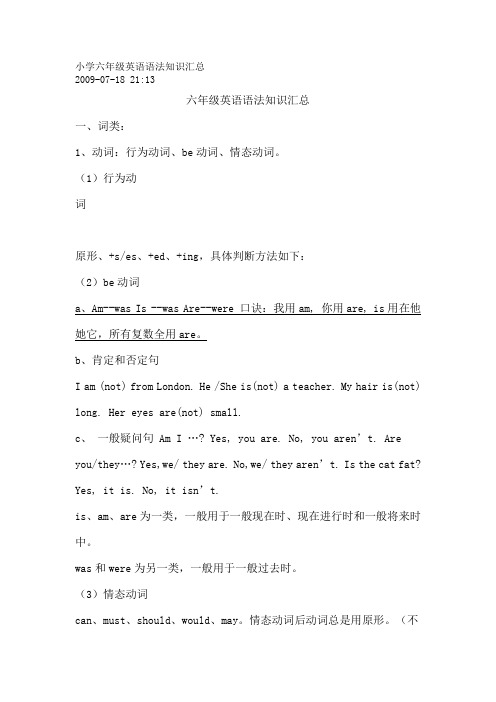
小学六年级英语语法知识汇总2009-07-18 21:13六年级英语语法知识汇总一、词类:1、动词:行为动词、be动词、情态动词。
(1)行为动词原形、+s/es、+ed、+ing,具体判断方法如下:(2)be动词a、Am--was Is --was Are--were 口诀:我用am, 你用are, is用在他她它,所有复数全用are。
b、肯定和否定句I am (not) from London. He /She is(not) a teacher. My hair is(not) long. Her eyes are(not) small.c、一般疑问句Am I …? Yes, you are. No, you aren’t. Are you/they…? Yes,we/ they are. No,we/ they aren’t. Is the cat fat? Yes, it is. No, it isn’t.is、am、are为一类,一般用于一般现在时、现在进行时和一般将来时中。
was和were为另一类,一般用于一般过去时。
(3)情态动词can、must、should、would、may。
情态动词后动词总是用原形。
(不受其他任何条件影响)2、名词这里强调两点:不可数名词都默认为单数,所以总是用is或者was。
如何加后缀:a.一般情况下,直接加-s,如:book-books, bag-bags, cat-cats, bed-bedsb.以s. x. sh. ch结尾,加-es,如:bus-buses, box-boxes, brush-brushes, watch-watchesc.以“辅音字母+y”结尾,变y为i, 再加-es,如:family-families, strawberry-strawberriesd.以“f或fe”结尾,变f或fe为v, 再加-es,如:knife-knives e.不规则名词复数: man-men, woman-women, policeman-policemen, policewoman-policewomen, mouse-mice child-childrenfoot-feet ,.tooth-teeth fish-fish, people-people,Chinese-Chinese, Japanese-Japanese3、形容词(包括副词)形容词表示某一事物或的特征,副词表示某一动作的特征。
小学六年级英语必须要掌握的语法知识点
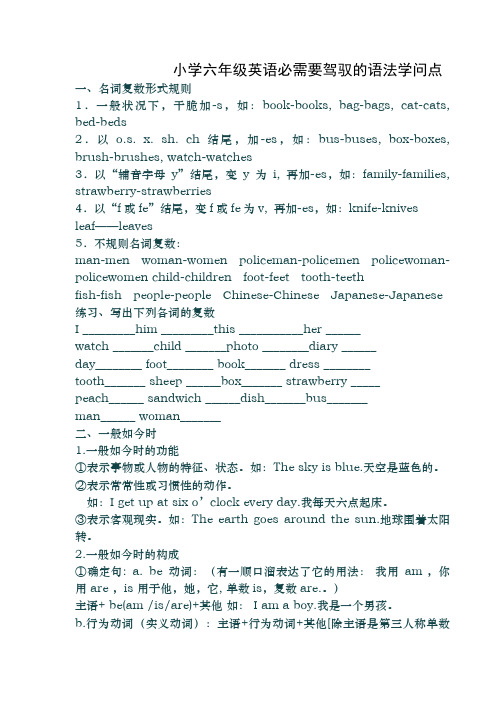
小学六年级英语必需要驾驭的语法学问点一、名词复数形式规则1.一般状况下,干脆加-s,如:book-books, bag-bags, cat-cats, bed-beds2.以o.s. x. sh. ch结尾,加-es,如:bus-buses, box-boxes, brush-brushes, watch-watches3.以“辅音字母y”结尾,变y为i, 再加-es,如:family-families, strawberry-strawberries4.以“f或fe”结尾,变f或fe为v, 再加-es,如:knife-knives leaf——leaves5.不规则名词复数:man-men woman-women policeman-policemen policewoman-policewomen child-children foot-feet tooth-teethfish-fish people-people Chinese-Chinese Japanese-Japanese 练习、写出下列各词的复数I _________him _________this ___________her ______watch _______child _______photo ________diary ______day________ foot________ book_______ dress ________tooth_______ sheep ______box_______ strawberry _____peach______ sandwich ______dish_______bus_______man______ woman_______二、一般如今时1.一般如今时的功能○1表示事物或人物的特征、状态。
如:The sky is blue.天空是蓝色的。
○2表示常常性或习惯性的动作。
如:I get up at six o’clock every day.我每天六点起床。
小学六年级的英语语法
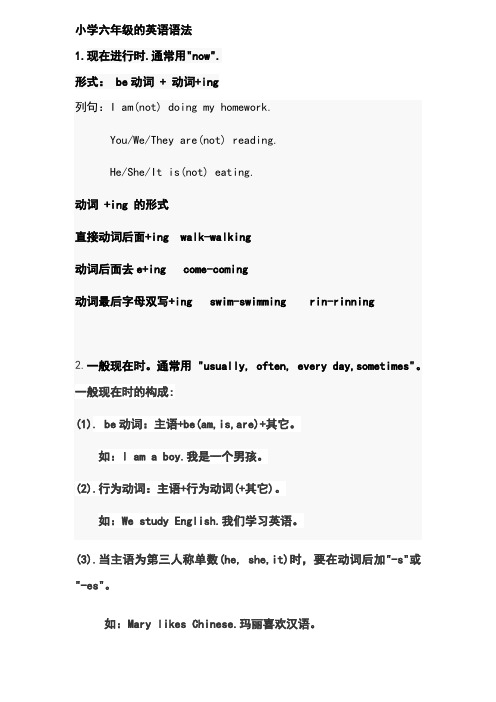
小学六年级的英语语法1.现在进行时.通常用"now".形式: be动词 + 动词+ing列句:I am(not) doing my homework.You/We/They are(not) reading.He/She/It is(not) eating.动词 +ing 的形式直接动词后面+ing walk-walking动词后面去e+ing come-coming动词最后字母双写+ing swim-swimming rin-rinning2.一般现在时。
通常用 "usually, often, every day,sometimes"。
一般现在时的构成:(1). be动词:主语+be(am,is,are)+其它。
如:I am a boy.我是一个男孩。
(2).行为动词:主语+行为动词(+其它)。
如:We study English.我们学习英语。
(3).当主语为第三人称单数(he, she,it)时,要在动词后加"-s"或"-es"。
如:Mary likes Chinese.玛丽喜欢汉语。
一般现在时的变化:(1)be动词的变化。
否定句:主语+ be + not +其它。
如:He is not a worker.他不是工人。
一般疑问句:Be +主语+其它如:-Are you a student?-Yes. I am. / No, I'm not.特殊疑问句:疑问词+一般疑问句。
如:Where is my bike?(2)行为动词的变化。
否定句:主语+ don't( doesn't ) +动词原形(+其它)。
如:I don't like bread.当主语为第三人称单数时,要用doesn't构成否定句。
如:He doesn't often play.一般疑问句:Do( Does ) +主语+动词原形+其它。
小学六年级英语语法及词汇汇总

By一、人称代词二、指示代词四、不定代词一、词类:1、动词:行为动词、be动词、情态动词。
(1)行为动词原形、+s/es、+ed、+ing,具体判断方法如下:(2)be动词a、Am--was Is --was Are--were 口诀:我用am, 你用are, is用在他她它,所有复数全用are。
b、肯定和否定句I am (not) from London. He /She is(not) a teacher. My hair is(not) long. Hereyes are(not) small.c、一般疑问句Am I …? Yes, you are. No, you aren’t. Are you/they…? Yes,we/ they are.No,we/ they aren’t. Is the cat fat? Yes, it is. No, it isn’t.is、am、are为一类,一般用于一般现在时、现在进行时和一般将来时中。
was和were为另一类,一般用于一般过去时。
(3)情态动词can、must、should、would、may。
情态动词后动词总是用原形。
(不受其他任何条件影响)2、名词这里强调两点:不可数名词都默认为单数,所以总是用is或者was。
如何加后缀:a.一般情况下,直接加-s,如:book-books, bag-bags, cat-cats, bed-bedsb.以s. x. sh. ch结尾,加-es,如:bus-buses, box-boxes, brush-brushes, watch-watchesc.以“辅音字母+y”结尾,变y为i, 再加-es,如:family-families, strawberry-strawberries d.以“f或fe”结尾,变f或fe为v, 再加-es,如:knife-knivese.不规则名词复数:man-men, woman-women, policeman-policemen, policewoman-policewomen,mouse-mice child-children foot-feet ,.tooth-teeth fish-fish, people-people,Chinese-Chinese, Japanese-Japanese3、形容词(包括副词)形容词表示某一事物或的特征,副词表示某一动作的特征。
小学六年级英语语法全

一、人称代词二、指示代词三、疑问代词四、不定代词五、数字和日期六年级英语语法知识汇总一、词类:1、动词:行为动词、be动词、情态动词。
(1)行为动词原形、+s/es、+ed、+ing,具体判断方法如下:(2)be动词a、Am--was Is --was Are--were 口诀:我用am, 你用are, is用在他她它,所有复数全用are。
b、肯定和否定句I am (not) from London. He /She is(not) a teacher. My hair is(not) long. Hereyes are(not) small.c、一般疑问句 Am I …? Yes, you are. No, you aren’t. Are you/they…? Yes,we/ they are.No,we/ they aren’t. Is the cat fat? Yes, it is. No, it isn’t.is、am、are为一类,一般用于一般现在时、现在进行时和一般将来时中。
was和were为另一类,一般用于一般过去时。
(3)情态动词can、must、should、would、may。
情态动词后动词总是用原形。
(不受其他任何条件影响)2、名词这里强调两点:不可数名词都默认为单数,所以总是用is或者was。
如何加后缀:a.一般情况下,直接加-s,如:book-books, bag-bags, cat-cats, bed-bedsb.以s. x. sh. ch结尾,加-es,如:bus-buses, box-boxes, brush-brushes, watch-watchesc.以“辅音字母+y”结尾,变y为i, 再加-es,如:family-families, strawberry-strawberriesd.以“f或fe”结尾,变f或fe为v, 再加-es,如:knife-knives e.不规则名词复数: man-men, woman-women, policeman-policemen, policewoman-policewomen,mouse-mice child-children foot-feet ,.tooth-teeth fish-fish, people-people,Chinese-Chinese, Japanese-Japanese3、形容词(包括副词)形容词表示某一事物或的特征,副词表示某一动作的特征。
小学六年级英语语法

一、人称代词二、指示代词三、疑问代词四、不定代词五、数字与日期六年级英语语法知识汇总一、词类:1、动词:行为动词、be动词、情态动词。
(1)行为动词原形、+s/es、+ed、+ing,具体判断方法如下:(2)be动词a、Am--was Is --was Are--were 口诀:我用am, 您用are, is用在她她它,所有复数全用are。
b、肯定与否定句I am (not) from London、He /She is(not) a teacher、My hair is(not) long、Hereyes are(not) small、c、一般疑问句Am I …? Yes, you are、No, you aren’t、Are you/they…? Yes,we/ they are、No,we/ they aren’t、Is the cat fat? Yes, it is、No, it isn’t、is、am、are为一类,一般用于一般现在时、现在进行时与一般将来时中。
was与were为另一类,一般用于一般过去时。
(3)情态动词can、must、should、would、may。
情态动词后动词总就是用原形。
(不受其她任何条件影响)2、名词这里强调两点:不可数名词都默认为单数,所以总就是用is或者was。
如何加后缀:a.一般情况下,直接加-s,如:book-books, bag-bags, cat-cats, bed-bedsb.以s、x、sh、ch结尾,加-es,如:bus-buses, box-boxes, brush-brushes, watch-watchesc.以“辅音字母+y”结尾,变y为i, 再加-es,如:family-families, strawberry-strawberriesd.以“f或fe”结尾,变f或fe为v, 再加-es,如:knife-knivese.不规则名词复数: man-men, woman-women, policeman-policemen, policewoman-policewomen,mouse-mice child-children foot-feet ,、tooth-teeth fish-fish, people-people,Chinese-Chinese, Japanese-Japanese3、形容词(包括副词)形容词表示某一事物或的特征,副词表示某一动作的特征。
小学六年级英语语法知识点汇总

小学六年级英语语法知识点汇总语法的学习,需要付出大量的时间和精力。
马上要到毕业考试了,为了帮助大家掌握小学英语的基础知识点.接下来是小编为大家整理的小学六年级英语语法知识点汇总,希望大家喜欢!小学六年级英语语法知识点汇总一一、重点短语:this morning 今天上午this afternoon 今天下午this evening 今天晚上next week 下周tomorrow 明天 tonight 今晚post card 明信片 comic book漫画书newspaper报纸二、重点句型:1.What are you going to do on the weekend?你周末打算做什么?2.I’m going to visit my grandparents this weekend?这个周末我打算去看望我的外祖父母。
3.Where are you going this afternoon? 你今天下午打算去哪里?4.I’m going to the bookstore.我打算去书店。
5.What are you going to buy?你打算去买什么?6.I’m going to buy a comic book.我打算去买一本漫画书。
三、重点语法:1、What are you going to do?你想做什么?询问他人在未来的打算。
be going to 后面要跟动词的原形。
注意be going to be 意思是"打算成为什么,干什么职业。
"注意一下句子的区别,找出正确回答。
What are you going to do this afternoon?What are you going to buy?What are you going to be?When? are you going?Where are you going?How are you going?Who are you going with?2、this evening 和tonight的区别:this evening指的是今天晚上睡觉以前的时间,一般指晚上十二点以前。
小学六年级英语语法要点

小学六年级英语语法一.名词复数规则1.一般情况下,直接加-s,如:book-books, bag-bags, cat-cats, bed-beds2.以s. x. sh. ch结尾,加-es,如:bus-buses, box-boxes, brush-brushes, watch-watches3.以“辅音字母+y”结尾,变y为i, 再加-es,如:family-families, strawberry-strawberries4.以“f或fe”结尾,变f或fe为v, 再加-es,如:knife-knives5.不规则名词复数:man-men, woman-women, policeman-policemen, policewoman-policewomen, mouse-micechild-childrenfoot-feet, tooth-teethfish-fish, people-people, Chinese-Chinese, Japanese-Japanese二.代词1.人称代词和物主代词1、人称代词:主格和宾格的区别:主格通常位于句中第一个动词之前(有时候位于than 之后),宾格一般位于动词或介词之后。
2、物主代词:形容词性与名词性的区别:形容词性用时后面一般要带上名词,名词性则单独使用,后面不带名词。
人称代词主格宾格物主代词形容词性名词性第一人称:我I me 我的my mine 我们we us 我们的our ours 第二人称:你,你们you you 你的,你们的your yours第三人称:他he him 他的his his她she her 她的her hers它it it 它的its its他(她,它)们they them 他(她,它)们的their theirs2.some & anysome 的用法some 一些,某些,某个。
可代替名词和形容词。
常用于肯定句。
在句子中用作主语、宾语、定语。
六年级英语语法知识点总结
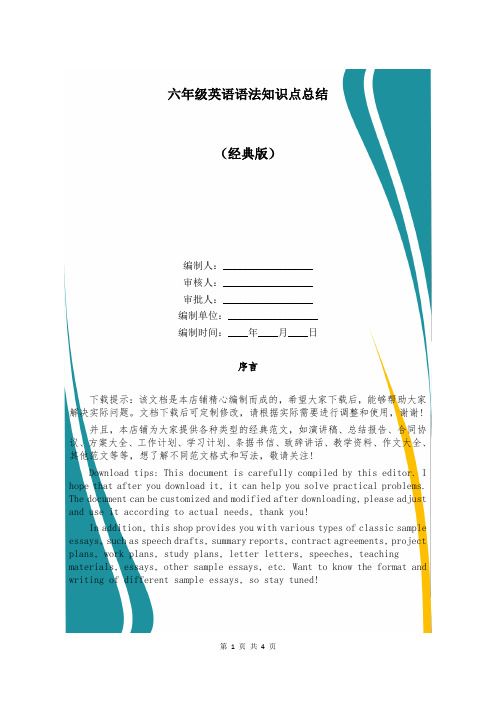
六年级英语语法知识点总结(经典版)编制人:__________________审核人:__________________审批人:__________________编制单位:__________________编制时间:____年____月____日序言下载提示:该文档是本店铺精心编制而成的,希望大家下载后,能够帮助大家解决实际问题。
文档下载后可定制修改,请根据实际需要进行调整和使用,谢谢!并且,本店铺为大家提供各种类型的经典范文,如演讲稿、总结报告、合同协议、方案大全、工作计划、学习计划、条据书信、致辞讲话、教学资料、作文大全、其他范文等等,想了解不同范文格式和写法,敬请关注!Download tips: This document is carefully compiled by this editor. I hope that after you download it, it can help you solve practical problems. The document can be customized and modified after downloading, please adjust and use it according to actual needs, thank you!In addition, this shop provides you with various types of classic sample essays, such as speech drafts, summary reports, contract agreements, project plans, work plans, study plans, letter letters, speeches, teaching materials, essays, other sample essays, etc. Want to know the format and writing of different sample essays, so stay tuned!六年级英语语法知识点总结语法(grammar)这个术语有两层含义,一个指结构规律本身,即平常说的语法事实,还有另一个指语法学。
六年级英语重点语法

六年级英语重点语法一、动词的时态1. 一般现在时The sun rises in the east.(太阳从东方升起。
)我们常用一般现在时来表达经常性的动作或习惯。
2. 一般过去时I watched a movie last night.(昨晚我看了一部电影。
)一般过去时用来表达过去发生的动作或状态。
3. 现在进行时They are playing football in the park.(他们正在公园里踢足球。
)现在进行时用来表达目前正在进行的动作。
4. 过去进行时She was studying for the exam when I called her.(当我打电话给她的时候,她正在为考试而学习。
)过去进行时用来表达在过去某个时间正在进行的动作。
5. 将来进行时I will be watching TV this time tomorrow.(明天这个时候我将会看电视。
)将来进行时表示将来某个时候正在进行的动作。
6. 将来完成时He will have finished his homework by 5 p.m.(他将会在下午五点之前完成作业。
)将来完成时表示将来某一时刻之前已经完成的动作。
7. 现在完成时We have visited the Great Wall.(我们参观过长城。
)现在完成时用来表达过去发生的动作对现在造成的影响或结果。
8. 过去完成时She had already eaten dinner when I arrived home.(当我到家时,她已经吃过晚饭了。
)过去完成时用来表示过去某一时间之前已经完成的动作。
二、名词1. 可数名词I have two dogs.(我有两只狗。
)可数名词可以加上数字和限定词进行数目的限定。
2. 不可数名词I like milk.(我喜欢牛奶。
)不可数名词不能用于单数形式,并且不能与不定冠词连用。
3. 复数名词The boys are playing basketball.(男孩们正在打篮球。
小学六年级英语语法知识点汇总
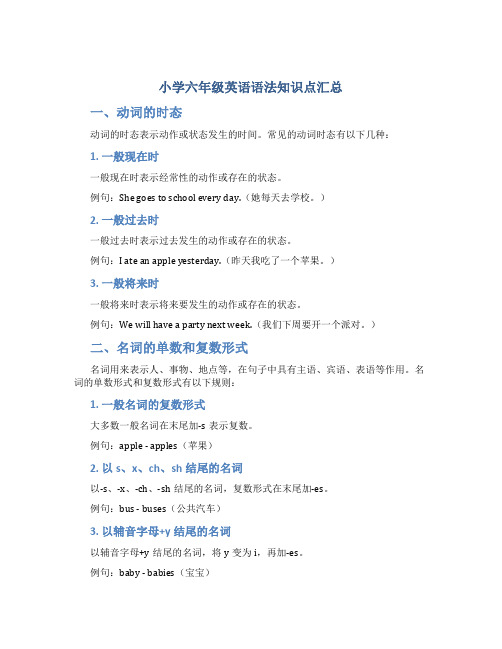
小学六年级英语语法知识点汇总一、动词的时态动词的时态表示动作或状态发生的时间。
常见的动词时态有以下几种:1. 一般现在时一般现在时表示经常性的动作或存在的状态。
例句:She goes to school every day.(她每天去学校。
)2. 一般过去时一般过去时表示过去发生的动作或存在的状态。
例句:I ate an apple yesterday.(昨天我吃了一个苹果。
)3. 一般将来时一般将来时表示将来要发生的动作或存在的状态。
例句:We will have a party next week.(我们下周要开一个派对。
)二、名词的单数和复数形式名词用来表示人、事物、地点等,在句子中具有主语、宾语、表语等作用。
名词的单数形式和复数形式有以下规则:1. 一般名词的复数形式大多数一般名词在末尾加-s表示复数。
例句:apple - apples(苹果)2. 以s、x、ch、sh结尾的名词以-s、-x、-ch、-sh结尾的名词,复数形式在末尾加-es。
例句:bus - buses(公共汽车)3. 以辅音字母+y结尾的名词以辅音字母+y结尾的名词,将y变为i,再加-es。
例句:baby - babies(宝宝)三、形容词的比较级和最高级形容词用来描述或修饰名词。
形容词的比较级和最高级有以下形式:1. 比较级的构成形容词比较级的构成通常在词尾加-er。
例句:tall - taller(高)2. 最高级的构成形容词最高级的构成通常在词尾加-est。
例句:tall - tallest(最高的)四、冠词的用法冠词用来修饰名词,有三个基本形式:不定冠词a/an、定冠词the和零冠词。
1. 不定冠词a/an不定冠词a/an用来表示泛指的意思,在单数名词前用a,在以辅音音素开头的单数名词前用an。
例句:a car(一辆汽车);an apple(一个苹果)2. 定冠词the定冠词the用来表示特指的意思,在特定的名词前使用。
小学六年级英语复习语法知识

小学六年级英语复习资料:语法篇一.名词:名词单复数,名词的格(一)名词单复数1.一般情况,直接加-s,如:book-books, bag-bags, cat-cats, bed-beds 2.以s. x. sh. ch结尾,加-es,如:bus-buses, box-boxes, brush-brushes, watch-watches3.以“辅音字母+y”结尾,变y为i, 再加-es,如:family-families,strawberry-strawberries4.以“f或fe”结尾,变f或fe为v, 再加-es,如:knife-knives5.不规则名词复数:man-men, woman-women, policeman-policemen, policewoman-policewom en, mouse-micechild-children, foot-feet, tooth-teeth, fish-fish, people-people, Chinese-C hinese, Japanese-Japanese不可数名词的复数就是原型:paper, juice, water, milk, rice, tea (二)名词的格(1) 有生命的东西的名词所有格:a) 单数后加’s如: Lucy’s ruler my father’s shirtb) 以s 结尾的复数名词后加’如: his friends’ bagsc) 不以s 结尾的复数后加’s children’s shoes并列名词中,如果把’s加在最后一个名词后,表示共有,如:Tom and Mike’s car汤姆和迈克共有的小汽车要表示所有物不是共有的,应分别在并列名词后加’sTom’s and Mike’s cars汤姆和麦克各自的小汽车(2)表示无生命东西的名词通常用“ of +名词”来表示所有关系:如:a picture of the classroom a map of China二.冠词:不定冠词,定冠词种类:(1)不定冠词:a / an a unit / an uncle元音开头的可数名词前用an :an egg / an apple / an orange / an eraser / an answer / an ID card / an alarm clock / an actor / an actress /an e-mail / an address / an event / an example / an opera / an hour /an old man / an interesting book / anexciting sport / an action movie / an art lesson /(2)定冠词:the the egg the plane2. 用法:定冠词的用法:(1)特指某(些)人或某(些)物:The ruler is on the desk.(2)复述上文提到的人或物:He has a sweater. The sweater is new.(3)谈话双方都知道的人或物:The boys aren’t at school.(4)在序数词前:John’s birthday is February the second.(5)用于固定词组中:in the morning / afternoon / evening不用冠词的情况:(1)专有名词前:China is a big country.(2)名词前有定语:this , that , my , your , some, any , no 等:This is my baseball.(3)复数名词表示一类人和事:Monkeys can’t swim.They are teachers. (4)在节日,日期,月份,季节前:Today is Christmas Day. It’s Sunday.(5)一日三餐前:We have breakfast at 6:30.(6)球类棋类运动前:They often play football after class. He plays chess at home.* 但乐器前要用定冠词:I play the guitar very well.(7)学科名称前:My favorite subject is music.(8)在称呼或头衔的名词前:This is Mr Li.(9)固定词组中:at noon at night by bus三、代词:人称代词,物主代词第一人称单数 I(我) me my(我的)复数 we(我们) us our(我们的)第二人称单数 you(你) you your(你的)复数 you(你们) you your(你们的)第三人称单数 he(他) him his(他的)she(她) her her(她的)it(它) it its(它的)复数 they(他们/她们/它们) them their(他们的/她们的/它们的)四、形容词,副词:比较级,最高级(一)、形容词的比较级1、形容词比较级在句子中的运用:两个事物或人的比较用比较级,比较级后面一般带有单词than。
(完整版)小学六年级英语语法及词汇汇总
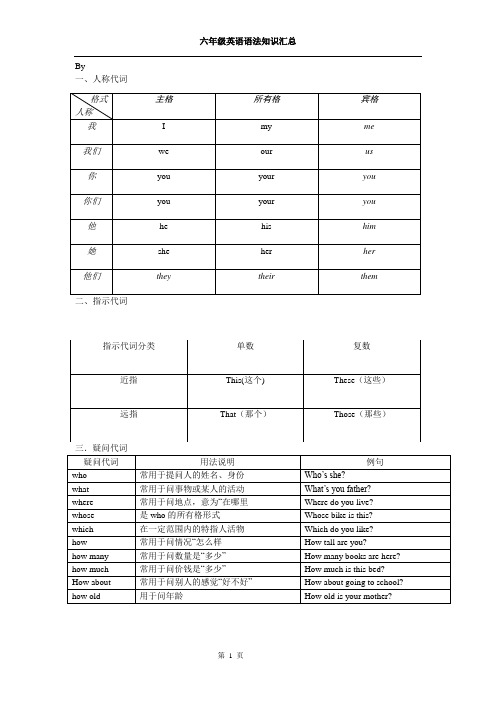
By一、人称代词二、指示代词四、不定代词一、词类:1、动词:行为动词、be动词、情态动词。
(1)行为动词原形、+s/es、+ed、+ing,具体判断方法如下:(2)be动词a、Am--was Is --was Are--were 口诀:我用am, 你用are, is用在他她它,所有复数全用are。
b、肯定和否定句I am (not) from London. He /She is(not) a teacher. My hair is(not) long. Hereyes are(not) small.c、一般疑问句Am I …? Yes, you are. No, you aren’t. Are you/they…? Yes,we/ they are.No,we/ they aren’t. Is the cat fat? Yes, it is. No, it isn’t.is、am、are为一类,一般用于一般现在时、现在进行时和一般将来时中。
was和were为另一类,一般用于一般过去时。
(3)情态动词can、must、should、would、may。
情态动词后动词总是用原形。
(不受其他任何条件影响)2、名词这里强调两点:不可数名词都默认为单数,所以总是用is或者was。
如何加后缀:a.一般情况下,直接加-s,如:book-books, bag-bags, cat-cats, bed-bedsb.以s. x. sh. ch结尾,加-es,如:bus-buses, box-boxes, brush-brushes, watch-watchesc.以“辅音字母+y”结尾,变y为i, 再加-es,如:family-families, strawberry-strawberries d.以“f或fe”结尾,变f或fe为v, 再加-es,如:knife-knivese.不规则名词复数:man-men, woman-women, policeman-policemen, policewoman-policewomen,mouse-mice child-children foot-feet ,.tooth-teeth fish-fish, people-people,Chinese-Chinese, Japanese-Japanese3、形容词(包括副词)形容词表示某一事物或的特征,副词表示某一动作的特征。
最全小学六年级英语语法知识汇总六年级英语语法知识汇总的知识点完整版

最全小学六年级英语语法知识汇总六年级英语语法
知识汇总的知识点完整版
以下是小学六年级英语语法知识的完整版本:
1. 时态:一般现在时、一般过去时、一般将来时、现在进行时、过去进行时、过去将来时。
2. 名词:单数、复数、可数名词、不可数名词。
3. 冠词:定冠词(the)、不定冠词(a/an)。
4. 代词:人称代词、物主代词、反身代词、指示代词、不定代词。
5. 形容词:形容词的基本用法、形容词的比较级、形容词的最高级。
6. 副词:副词的基本用法、副词的比较级、副词的最高级。
7. 动词:动词的基本形式、动词的过去式、动词的现在分词、动词的过去分词、助动词、情态动词、动词的时态与语态。
8. 介词:常见的介词、介词短语的用法。
9. 连词:并列连词、从属连词、关系连词。
10. 疑问句:特殊疑问词、一般疑问句、特殊疑问句的回答。
11. 句子结构:主语、谓语、宾语、表语、状语、宾补等。
12. 被动语态:被动语态的构成、被动语态的时态。
13. 间接引语:直接引语、间接引语的变化。
14. 数词:基数词、序数词。
15. 缩略词:缩写形式、缩略语。
以上是小学六年级英语语法知识的完整版本,可以根据需要逐一学习和掌握这些知识点。
(完整版)小学六年级英语语法知识汇总

(完整版)小学六年级英语语法知识汇总小学六年级英语语法知识汇总一、词类:1、动词:行为动词、be动词、情态动词。
(1)行为动词原形、+s/es、+ed、+ing,具体推断办法如下:(2)be动词a、Am--was Is --was Are--were 口诀:我用am, 你用are, is用在他她它,所有复数全用are。
b、确信和否定句I am (not) from London. He /She is(not) a teacher. My hair is(not) long. Her eyes are(not) small.c、普通疑咨询句Am I …? Yes, you are. No, you aren’t. Are you/they…? Yes,w e/ they are. No,we/ they aren’t. Is the cat fat? Yes, it is. No, it isn’t.is、am、are为一类,普通用于普通如今时、如今举行时和普通未来时中。
was和were为另一类,普通用于普通过去时。
(3)情态动词can、must、should、would、may。
情态动词后动词总是用原形。
(别受其他任何条件妨碍)2、名词这个地方强调两点:别可数名词都默以为单数,因此总是用is或者was。
怎么加后缀:a.普通事情下,直截了当加-s,如:book-books, bag-bags, cat-cats, bed-bedsb.以s. x. sh. ch结尾,加-es,如:bus-buses, box-boxes, brush-brushes, watch-watchesc.以“辅音字母+y”结尾,变y为i, 再加-es,如:family-families,strawberry-strawberriesd.以“f或fe”结尾,变f或fe为v, 再加-es,如:knife-knivese.别规则名词复数:man-men, woman-women, policeman-policemen, policewoman-policewomen, mouse-mice child-childrenfoot-feet ,.tooth-teeth fish-fish, people-people, Chinese-Chinese, Japanese-Japanese3、形容词(包括副词)形容词表示某一事物或的特征,副词表示某一动作的特征。
小学六年级英语语法知识点汇总

小学六年级英语语法知识点汇总语法的学习,需要付出大量的时间和精力。
马上要到毕业考试了,为了帮助大家掌握小学英语的基础知识点.接下来是小编为大家整理的小学六年级英语语法知识点汇总,希望大家喜欢!小学六年级英语语法知识点汇总一一、重点短语:this morning 今天上午this afternoon 今天下午this evening 今天晚上next week 下周tomorrow 明天 tonight 今晚post card 明信片 comic book漫画书newspaper报纸二、重点句型:1.What are you going to do on the weekend?你周末打算做什么?2.I’m going to visit my grandparents this weekend?这个周末我打算去看望我的外祖父母。
3.Where are you going this afternoon? 你今天下午打算去哪里?4.I’m going to the bookstore.我打算去书店。
5.What are you going to buy?你打算去买什么?6.I’m going to buy a comic book.我打算去买一本漫画书。
三、重点语法:1、What are you going to do?你想做什么?询问他人在未来的打算。
be going to 后面要跟动词的原形。
注意be going to be 意思是"打算成为什么,干什么职业。
"注意一下句子的区别,找出正确回答。
What are you going to do this afternoon?What are you going to buy?What are you going to be?When? are you going?Where are you going?How are you going?Who are you going with?2、this evening 和tonight的区别:this evening指的是今天晚上睡觉以前的时间,一般指晚上十二点以前。
小学六年级英语语法

一、人称代词二、指示代词三、疑问代词四、不定代词五、数字和日期六年级英语语法知识汇总一、词类:1、动词:行为动词、be动词、情态动词。
(1)行为动词原形、+s/es、+ed、+ing,具体判断方法如下:(2)be动词a、Am--was Is --was Are--were 口诀:我用am, 你用are, is用在他她它,所有复数全用are。
b、肯定和否定句I am (not) from London. He /She is(not) a teacher. My hair is(not) long. Hereyes are(not) small.c、一般疑问句Am I …? Yes, you are. No, you aren’t. Are you/they…? Yes,we/ they are.No,we/ they aren’t. Is the cat fat? Yes, it is. No, it isn’t.is、am、are为一类,一般用于一般现在时、现在进行时和一般将来时中。
was和were为另一类,一般用于一般过去时。
(3)情态动词can、must、should、would、may。
情态动词后动词总是用原形。
(不受其他任何条件影响)2、名词这里强调两点:不可数名词都默认为单数,所以总是用is或者was。
如何加后缀:a.一般情况下,直接加-s,如:book-books, bag-bags, cat-cats, bed-beds b.以s. x. sh. ch结尾,加-es,如:bus-buses, box-boxes, brush-brushes,watch-watchesc.以“辅音字母+y”结尾,变y为i, 再加-es,如:family-families, strawberry-strawberriesd.以“f或fe”结尾,变f或fe为v, 再加-es,如:knife-knives e.不规则名词复数:man-men, woman-women, policeman-policemen, policewoman-policewomen,mouse-mice child-children foot-feet ,.tooth-teeth fish-fish, people-people,Chinese-Chinese, Japanese-Japanese3、形容词(包括副词)形容词表示某一事物或的特征,副词表示某一动作的特征。
- 1、下载文档前请自行甄别文档内容的完整性,平台不提供额外的编辑、内容补充、找答案等附加服务。
- 2、"仅部分预览"的文档,不可在线预览部分如存在完整性等问题,可反馈申请退款(可完整预览的文档不适用该条件!)。
- 3、如文档侵犯您的权益,请联系客服反馈,我们会尽快为您处理(人工客服工作时间:9:00-18:30)。
小学六年级英语语法
一、基数词,序数词
序数词前一定要加“the”,序数词一般用于:①日期【the 号(序数词)of 月】②【第几…】③【名次】
二、动词
1. be动词(am/is/are)
主语be动词(原形)be动词(过去式)
I am was He/she/it is was
We/you/they are were
2.助动词(do/does/did)问句答句
Do+非第三人称单数+动词原形…?
…do/don’t
Does+第三人称单数
…does/doesn’t
Did+所有主格
…did/didn’t
问句答句
What do you/they/we…+动词原形?
I/They/We+动词原形…。
What does he/she/it…
He/She/It +(动词+S)….
What did you/they/we/ he/she/it…
I/They/We/ He/She/It +动词过去式。
3.情态动词(can,must,could,would,may,shall,would)
情态动词后面都跟动词原形
三、介词
①in+月、年the morning/afternoon/evening/a week
表示时间
②on+具体某一天(几月几日)/某个假期(…Day)
③at+具体某点时间、某个假期(…Festival)/the weekend
表示方位
①in…street
②on…road/left/right
③at the…crossing/stop/某个具体的地点
①in the tree(不是树上长出来的)
②on the tree(树上原来自己长出来的)
表示时间:①ago(……以前) later(……以后)
②before (在……以前) after(在……以后)
一、名词
1.不可数名词:bread,juice,tea,coffee,water,chocolate,rice,paper(不可数名词相对应的be动词永远都是is/was)
2、名词复数规则
(1).一般情况下,直接加-s,如:book-books, bag-bags, cat-cats, bed-beds (2).以s. x. sh. ch结尾,加-es,如:bus-buses, box-boxes, brush-brushes,
watch-watches
(3).以“辅音字母+y”结尾,变y为i, 再加-es,如:family-families, strawberry-strawberries
(4).以“f或fe”结尾,变f或fe为v, 再加-es,如:knife-knives
(5)不规则名词复数:man ---men, woman---women, policeman---policemen, policewoman---policewomen, mouse---mice child---children foot---feet,.tooth---teeth fish---fish, people---people, Chinese---Chinese, Japanese---Japanese
1. 主格一般用在句中作为主语,一般用在动词前(除疑问句)
2. 宾格多用于动词介词后面。
3. 形容词性物主代词后面必须要跟名词。
4. 名次性物主代词=形容词性物主代词+名词
三、形容词及副词的比较级
1. 形容词比较级用于两者比较,基本句式为:(A)主格+be|+形容词比较级+than+B(宾格)。
2. 副词比较级基本句式为:(A)主格+动词|+副词比较级+than+B(宾格)。
3. 比较级的用法:
①一般+er
②双写最后一个字母+er,
如thin—thinner,big—bigger,fat—fatter,hot—hotter,
③不规则的比较级:
good/well—better,many/much—more,far—farther/further
4. 一样的情况用as…as,句式为:as 原级as
5. 注意:too,very+原级。
